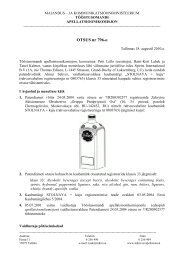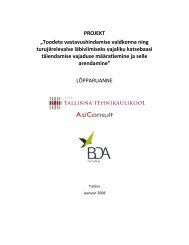Feasibility study for an Estonian Materials Technology Programme
Feasibility study for an Estonian Materials Technology Programme
Feasibility study for an Estonian Materials Technology Programme
Create successful ePaper yourself
Turn your PDF publications into a flip-book with our unique Google optimized e-Paper software.
70<br />
<strong>Feasibility</strong> <strong>study</strong> <strong>for</strong> <strong>an</strong> Estoni<strong>an</strong> <strong>Materials</strong> <strong>Technology</strong> <strong>Programme</strong><br />
3. <strong>Materials</strong> technology abroad: co-operation <strong>an</strong>d competition<br />
Energy<br />
Knowledge <strong>an</strong>d ability to adopt functional materials <strong>an</strong>d n<strong>an</strong>otechnology enable success in various<br />
energy technologies such as solar, wind, hydrogen technology, batteries, fuel cells <strong>an</strong>d environmentally<br />
friendly gas technology<br />
Building <strong>an</strong>d construction<br />
Main value added is based on utilisation of locally available raw materials<br />
Oil <strong>an</strong>d gas<br />
The country has a very strong position in offshore engineering <strong>an</strong>d other related technologies<br />
ICT<br />
Success based on knowledge in specific niche areas: integration of adv<strong>an</strong>ced functional materials <strong>an</strong>d<br />
silicon n<strong>an</strong>otechnology<br />
Based on the strategy studies, Norway established a NANOMAT programme <strong>for</strong> n<strong>an</strong>otechnology <strong>an</strong>d new<br />
materials, n<strong>an</strong>oscience <strong>an</strong>d integration. For the period of 2007-2016, the programme focuses in four thematic<br />
areas in the following priority order: 1) energy <strong>an</strong>d environment, 2) ICT including microsystems, 3)<br />
health <strong>an</strong>d biotechnology, 4) oce<strong>an</strong> <strong>an</strong>d food. By 2016, the <strong>an</strong>nual budget of the NANOMAT programme<br />
is expected to reach approximately 30 million EUR. The sub areas under the selected priority areas are strikingly<br />
similar to Estoni<strong>an</strong> competences:<br />
Energy <strong>an</strong>d environment<br />
Gas conversion, CO2 capture, petroleum production, solar p<strong>an</strong>els, hydrogen technology, batteries <strong>an</strong>d<br />
energy harvesters, energy efficiency, biofuels<br />
ICT inclusive microsystems:<br />
N<strong>an</strong>omaterials <strong>an</strong>d n<strong>an</strong>ocomponents <strong>for</strong> electronics, data storage, optics, sensors, actuators <strong>an</strong>d RF<br />
components, integration of n<strong>an</strong>omaterials into sensors <strong>an</strong>d actuators, n<strong>an</strong>ostructuring, n<strong>an</strong>ofluidics<br />
Health <strong>an</strong>d biotechnology<br />
Biocompatible materials, sensors <strong>an</strong>d diagnostics, medication<br />
Oce<strong>an</strong> <strong>an</strong>d food<br />
Tracing of food, smart packaging, food monitoring, surface treatment to prevent algal <strong>an</strong>d bacterial<br />
growth<br />
It is clearly identified that future success in adv<strong>an</strong>ced materials requires high degree of interdisciplinary collaboration<br />
<strong>an</strong>d convergence in various disciplines including: physics, materials science <strong>an</strong>d technology, chemistry<br />
<strong>an</strong>d biochemistry, molecular <strong>an</strong>d cellular technology, optics, surface science, microelectronics <strong>an</strong>d scientific<br />
instrumentation. Thus, in addition to the selected thematic areas, success in materials technology needs strong<br />
support from fundamental sciences as well as expertise in modern tools including synthesis, m<strong>an</strong>ipulation <strong>an</strong>d<br />
fabrication, characterisation <strong>an</strong>d modelling.<br />
3.2.6 Denmark<br />
Denmark became more active in materials research long time ago when the government decided to establish<br />
National Research Strategies in selected key areas import<strong>an</strong>t <strong>for</strong> the D<strong>an</strong>ish society <strong>an</strong>d economy. The country<br />
had <strong>Materials</strong> <strong>Technology</strong> <strong>Programme</strong>s ongoing from 1988 to 1997 <strong>an</strong>d in 1999 The D<strong>an</strong>ish National Strategy<br />
<strong>for</strong> <strong>Materials</strong> Research was created. The country spent 300 million DKK (40 MEUR) <strong>an</strong>d 500 person years in<br />
materials research <strong>an</strong>d development already in 1995 <strong>an</strong>d by 1997 the amount of funding had almost doubled<br />
to 900 million DKK. The reason <strong>for</strong> selecting materials technology as a strategic area was that materials affect<br />
the development within all other technological or scientific areas.<br />
The goals <strong>for</strong> the National Research Strategy in materials defined in 1999 were:<br />
Technological innovation <strong>an</strong>d increased employment<br />
<strong>Materials</strong> research is often a prerequisite <strong>for</strong> progress in other technological areas<br />
Improvements in the quality of life, the environment <strong>an</strong>d health<br />
<strong>Materials</strong> strongly contribute to improving the quality of life<br />
Higher quality of education, <strong>an</strong>d accelerated production <strong>an</strong>d dissemination of knowledge<br />
To maintain the high quality of D<strong>an</strong>ish materials research





